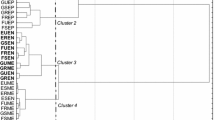Abstract
The breaking of dormancy in apple buds (Malus domestica Borkh cv. York Imperial) by thidiazuron (N-phenyl-N′-1,2,3,-thidiazol-5-ylurea) was investigated in relation to catalase, peroxidase, and polyphenol oxidase activities and their isoenzyme patterns. The activity and number of isoenzymic components of catalase increased progressively during bud break, then decreased after buds started to grow. Peroxidase activity was highest during dormancy and declined during bud swell, increased at bud break, and decreased after bud expansion. Several isoperoxidases were observed in gel electrophoresis. Similar patterns were found at different growth stages of apple buds except for one peroxidase isoenzyme, P3, which disappeared 12 days after thidiazuron treatment. There was an inverse relationship between the activities of polyphenol oxidase and peroxidase during the development of apple buds. Apple buds have a very similar polyphenol oxidase isoenzyme pattern throughout bud development. However, the appearance and disappearance of minor isoenzymes were also observed. Phloridzin, rutin, p-coumaric, epicatechin, naringin, chlorogenic acid, and catechol were found in apple buds. Among them, phloridzin, rutin, and p-coumaric were the dominant phenolic compounds. Dormant buds contained a high amount of phenolic substances which decreased after bud break (4 days after thidiazuron treatment) then increased until the start of bud expansion. Phenolic compounds are found to be potent modifiers of catalase, peroxidase, and polyphenol oxidase activity, as both inhibitors and stimulators in apple buds.
Similar content being viewed by others
References
Beckman L, Johnson FM (1964) Genetic control of aminopeptidase inDrosophilia melanogaster. Hereditas 51:221–230
Beckman L, Scandalios JG, Brebaker JL (1964) Genetics of leucine-aminopeptidase isozymes in maize. Genetics 50:899–904
Bradford MM (1976) A rapid and sensitive method for the quantitation of microgram quantities of protein utilizing the principle of protein-dye binding. Anal Biochem 72:248–254
Burris RH (1960) Hydroperoxidase (peroxidases and catalases). In: Ruhland W (ed) Encyclopedia of plant physiology, vol. 12. Springer-Verlag, Berlin, pp 365–400
Coseteng MY, Lee CY (1987) Changes in apple polyphenol oxidase and polyphenol concentrations in relation to degree of browning. J Food Sci 52:985–989
Gad AE, Ben-Efraim I (1988) Promotion of adventitious root formation by 4-chlororesorcinol: A polyphenol oxidase inhibitor. Plant Growth Regul 7:91–99
Galston AW, Lavee S, Siegel BZ (1968) The induction and repression of peroxidase isozymes by indoleacetic acid. In: Wightman F, Setterfield G (eds) Biochemistry and physiology of plant growth substances. Runge Press, Ottawa, Canada, pp 455–472
Halevy AH (1963) Interaction of growth retarding compounds and gibberellin in indoleacetic acid oxidase and peroxidase of cucumber seedlings. Plant Physiol 38:731–737
Harborne JB, Simmonds NW (1964) The natural distribution of the phenolic aglycones. In: Harborne JB (ed) Biochemistry of phenolic compounds. Academic Press, New York, pp 77–127
Kaminski W, Rom R (1974) A possible role of catalase in the rest of peachPrunus persica Sieb. and Zucc. flower buds. J Am Hort Sci 99:84–86
Nir G, Shulman Y, Fanberstein L, Lavee S (1986) Changes in the activity of catalase (EC 1.11.1.6) in relation to the dormancy of grapevine (Vitis vinifera L.) buds. Plant Physiol 81:1140–1142
Omran RG (1977) The direct involvement of hydrogen peroxide in indoleacetic acid inactivation. Biochem Biophys Res Commun 78:970–976
Pollock BM (1953) The respiration of Acer buds in relation to the inception and termination of winter rest. Physiol Plant 6:47–64
Scandalios JG (1969) Genetic control of multiple molecular forms of enzymes in plants: A review. Biochem Gen 3:37–79
Shannon LM (1968) Plant isoenzymes. Annu Rev Plant Physiol 19:187–210
Shannon LM (1969) Plant isoenzymes. Annu Rev Biochem 38:189–210
Sheen SJ, Calvert J (1969) Studies on polyphenol contents, activities and isozymes of polyphenol oxidase and peroxidase during air-curing in three tobacco types. Plant Physiol 44:199–204
Sigma Chemical Company (1986) Nondenatural protein molecular weight marker kit. Tech Bulletin No. MKR-137, pp 1–8
Srivastava OP, Van Huystee RB (1973) Evidence for close association of peroxidase, polyphenol oxidase, and IAA oxidase isozymes of peanut suspension culture medium. Can J Bot 51:2207–2215
Stonier T, Yang H (1973) Studies on auxin protectors. XI. Inhibition of peroxidase catalyzed oxidations of glutathione by auxin protectors and O-dihydroxyphenols. Plant Physiol 51:391–395
Thornton NC (1965) Importance of oxygen supply in secondary dormancy and its relation to the inhibiting mechanism regulating dormancy. Contr Boyce Thomp Inst 13:487–501
Upadhyaya MD, Yee J (1968) Isoenzyme polymorphism in flowering plants. VII. Isoenzyme variations in tissues of barley seedling. Phytochemistry 7:937–943
Wang SY, Faust M (1988a) Changes of fatty acids and sterols in apple buds during bud break induced by a plant bioregulator, thidiazuron. Physiol Plant 72:115–120
Wang SY, Faust M (1988b) Metabolic activities during dormancy and blooming of deciduous fruit trees. Isr J Bot 37:227–243
Wang SY, Ji ZL, Sun T, Faust M (1987) Effect of thidiazuron on abscisic acid content in apple bud relative to dormancy. Physiol Plant 71:105–109
Wang SY, Steffens GL, Faust M (1986) Breaking bud dormancy in apple with a plant bioregulator, thidiazuron. Phytochemistry 25:311–317
Yip CC (1964). The hydroxylation of proline by horseradish peroxidase. Biochem Acta 92:395–396
Author information
Authors and Affiliations
Rights and permissions
About this article
Cite this article
Wang, S.Y., Jiao, H.J. & Faust, M. Changes in the activities of catalase, peroxidase, and polyphenol oxidase in apple buds during bud break induced by thidiazuron. J Plant Growth Regul 10, 33–39 (1991). https://doi.org/10.1007/BF02279308
Received:
Accepted:
Issue Date:
DOI: https://doi.org/10.1007/BF02279308




